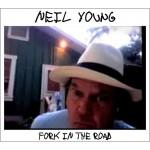
Neil Young Fork in the Road
(Reprise)
When 2007’s Chrome Dreams II came out, it was nice to have the old Neil Young back. Not the grumpy old man of Living With War (2006) but the reflective statesman who just loved a cool breeze in his hair and an old country road. We should all be careful what we wish for.
Young’s latest, Fork in the Road, sure has those breezes and those roads. Lots of them. And the car that rides on it. And its fuel lines. And mechanic.
As most every skeptical music fan knows by now, Fork in the Road is essentially a concept album about Young’s very own motorized Rosebud, a 1959 Lincoln Continental with custom electric engine – because, you know, those hybrids are just for sissies.
Of course, this is Neil Young we’re talking about, so he could be singing about his custom-crafted Razor Scooter made from 100% potato spud and still make an album that rocks. Musically, Fork in the Road is much grittier and grungier than Chrome Dreams II, sounding quite a bit like the heavier moments of Freedom (1989). Fuel Line manages to get your head begrudgingly bobbing despite its silly “Fill ‘er up!” refrain, while Just Singing a Song is classic Young gutter rock. Through and through, this is the liveliest we’ve seen Young in a while (I guess a new car can do that to an aging hippy). In fact, the music saves this album from certain disaster – an idea that, at its root is perplexing at best, is executed in an even more clumsy and confusing way.
What kind of message was Young aiming for, exactly? Get Behind the Wheel borders on a salival Tim “The Toolman” Taylor idolatry for a very expensive custom car, while Cough Up the Bucks reflects on the devastated economy. Then there is Johnny Magic, which, with lyrics like “She was born to run on a proud highway” and “Then the whole world started running out of money”, seems to insinuate both! It’s hard to take Young seriously when he talks about the economy while the theme of his album is a car that he dropped (according to one source) $120,000 on.
It’s just a strange, inappropriate time to write a love letter to a fashion accessory (it’s a weird description, but Young has a weird sense of fashion). What relevance does a message like that have in an economy like this, especially one where a place like Detroit is sinking into quick sand? Are we all supposed to go out and find ourselves a “Johnny Magic” to make all our Hummers and Broncos into energy-efficient electro-machines? For someone who has historically been vocal about current affairs (Living With War wasn’t that long ago), it’s an uncomfortable detour.
Fans of the album may argue that the concept is escapist in a time of despair, but who’s the one escaping here? This isn’t fiction – one of us is driving around in a luxury electric automobile, and it’s certainly not me! We don’t need a multi-millionaire rock musician to help get us through a recession by gloating about his green machine. If you can manage to tune out Young’s fawning, you may enjoy the exuberance on display here. If not, this is one attempted message that will likely leave you in the dust.
23 April, 2009 - 17:06 — Andy Pareti